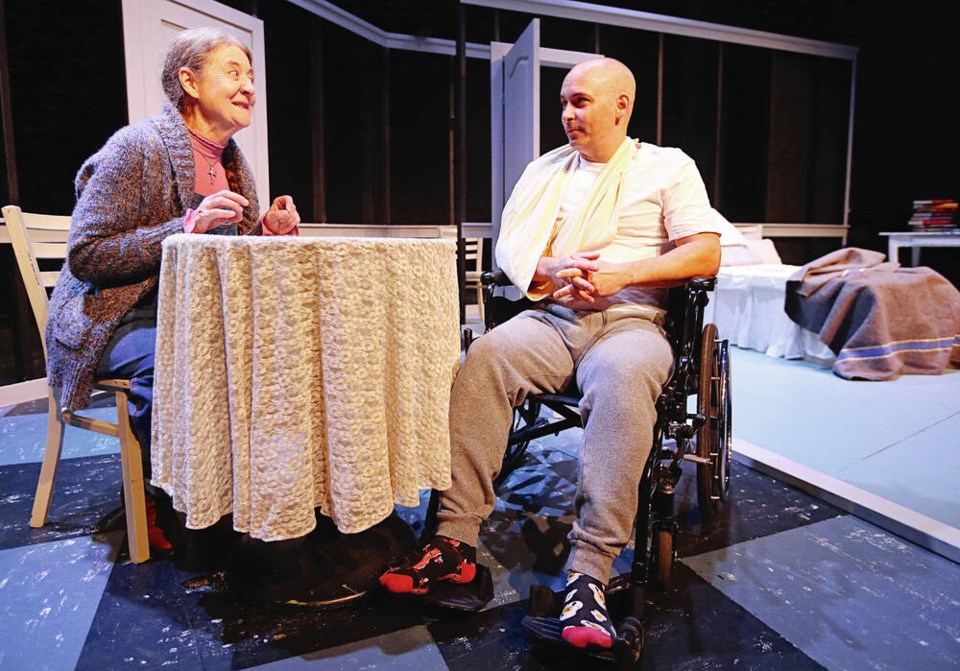The odd thing about Misery, the horror-thriller play, is that most audiences know the story even before the curtain rises.
After all, the 1990 film of the same name, starring Kathy Bates and James Caan, was a box-office hit. And the movie was based on a highly popular 1987 novel by Stephen King.
Given this history, the climactic conclusion of the stage version is, for many, hardly a surprise. And yet (despite it being a thriller) it hardly matters, as a strong new production by Blue Bridge Repertory Theatre proves. The show’s claustrophobic atmosphere, combined with its sense of impending inescapable doom, is what ultimately makes this a compelling and entertaining night of theatre.
For those who need it, here’s Misery’s plot. Paul is a famous author badly injured when his 1965 Mustang careens off the road in a small Colorado town during a snowstorm. He’s rescued by Annie, a former nurse who cares for him in her home.
The bad news: Annie’s also an uber-fan who’s weirdly obsessed with Paul’s novels. Even worse, she’s utterly bonkers. The bedridden writer, fed a steady diet of pain-killers, eventually realizes his caretaker has no intention of letting him free. Instead, Annie forces him to write a new novel, part of a romance series featuring a character named Misery.
Of course, what follows is even worse.
This stage 2015 adaptation by William Goldman, which follows the movie pretty faithfully, had a short Broadway run. There’s been a least two other stage versions — Misery was also reinvented as “feel bad” musical by a Dutch composer.
For my money, Misery works just as well as a play as a movie. Perhaps even better. While a police officer (Sarah Murphy) does make a brief appearance, the show’s essentially a two hander. Another bonus for cash-strapped theatre companies — it takes place in just a couple of rooms.
The key to making Misery work is enlisting a great actor to play Annie. By contrast, the smaller role of Paul is essentially reactive — he’s responding to Annie’s bizarro-world antics, whether they be torching the only existing manuscript of Paul’s new novel (too many swear words) or whacking his already ruined legs with a baseball bat.
Happily, we’ve got the highly capable Naomi Simpson in the lynch-pin role of Annie. A veteran of film, TV and theatre, Simpson made the character everything one could hope for, offering a confident and powerful performance on Thursday night.
Annie’s definitely a type. She’s an crusty eccentric loner in jean overalls who raises chickens and pigs and uses outdated slang such as “cockadoodie.” Simpson absolutely captured this in her assured performance, delivering her lines with a backwoods cadence. And she managed to bring out Annie’s craziness convincingly without overdoing it. Simpson’s aware the play’s tone can be ruined if the character is played too broadly — something Michael Armstrong also recognizes in his clear-headed direction.
Another solid actor, Trevor Hinton, shines in the role of Paul. In some ways it’s the more difficult role. The character is (1) essentially submissive and (2) stuck lying in bed much of the play. Hinton cleverly brought out Paul’s quiet intensity, we sense the conflicting impulses percolating beneath an acquiescent demeanor.
Misery continues at the Roxy Theatre to Dec. 3.
***
Dance Victoria’s season got off to a wonderful start last week with the Gibney Company, a contemporary troupe from New York making its first appearance in this city. Performing at the Royal Theatre Nov. 17 and 18, the company impressed with its precision and technical prowess.
The main offering was Bliss, a 27-minute work set to a solo selection from The Köln Concert by pianist Keith Jarrett.
It’s an expansive improvisatory recording with elements of gospel, jazz and R & B, often thunderous and joyous, notable for Jarrett’s occasional ecstatic groans and shouts. (For some reason it was played much too loudly on Nov. 17 — the high notes had a disconcerting ice-pick effect.)
Choreographed by Johan Inger, Bliss has a celebratory atmosphere that suits the music. Sometimes the 12 dancers performed as a full ensemble, elsewhere breaking into smaller groups or even an intimate pas de deux. The style ranged from free-form vernacular dance (sometimes dancers ran the length of the stage or jogged in place) to hints of classical ballet. A sense of resilience and joy — a rejoicing in simple humanity — came through powerfully.
My favourite was the opener, Sara, choreographed by Sharon Eyal and Gai Behar. The electronic music is stark and elemental, especially Karin Elizabeth Dreijer’s From Off to On, dominated by lines of blipping eighth notes and ominous whisper-singing.
Appearing both slinky and a touch kinky, seven dancers wore semi-gloss black unitards. Again, the movement reflected the score. Dimly lit performers moved in a sinuous, organic manner only to brusquely undercut the effect with abrupt head jerks, like a movie arbitrarily shifted several frames forward. There was a tortured sense of restraint and release.
The effect was sculptural, mesmerizing, powerful.
The evening’s other offering was A Measurable Existence by Yue Yin, set to a lively, often percussive score by Rutger Zuydervelt. The theme is self-discovery through human interaction, with dancers moving in disharmony only to shift to unison movement. A grid of orange light was lowered from above at an odd angle, giving the ominous sense of something gone awry. Ultimately the dance — replete with challenging lifts and turns — resolves to convey a pleasingly symbiotic world.



